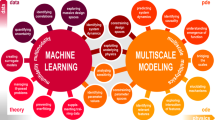Abstract
In recent years, quantum algorithms have emerged as a groundbreaking approach toward solving complex computational problems, particularly in physical modeling and artificial intelligence. This study introduces a novel quantum algorithm termed the duality game, tailored for addressing challenges in body dynamics modeling. The practicality and efficacy of the proposed algorithm are elucidated through three distinct data scenarios: (1) approximation of classical von Bertalanffy growth in the presence of random noise (simulated), (2) personalized tumor burden modeling leveraging a small dataset, and (3) modeling of COVID-19 population growth employing big data analytics. The algorithm’s performance in these scenarios underscores its potential for practical applications at a large scale. Moreover, the findings foster optimism regarding the algorithm’s promise in the burgeoning field of physical-based quantum artificial intelligence (quantum AI). Through the duality game, a pathway is delineated for addressing real-world problems in body dynamics, opening avenues for further research and development in quantum AI, aimed at harnessing quantum computational advantages for solving intricate physical modeling problems.












Similar content being viewed by others
Data Availability
The data used in this study are available upon request from the corresponding author.
References
Abbas, A., Sutter, D., Zoufal, C., Lucchi, A., Figalli, A., Woerner, S.: The power of quantum neural networks. Nat. Comput. Sci. 1(6), 403–409 (2021)
Bergholm, V., Izaac, J., Schuld, M., Gogolin, C., Alam, M.S., Ahmed, S., Arrazola, J.M., Blank, C., Delgado, A., Jahangiri, S., et al.: Pennylane: automatic differentiation of hybrid quantum-classical computations (2018). arXiv preprint arXiv:1811.04968
Carleo, G., Cirac, I., Cranmer, K., Daudet, L., Schuld, M., Tishby, N., Vogt-Maranto, L., Zdeborová, L.: Machine learning and the physical sciences. Rev. Mod. Phys. 91(4), 045002 (2019)
Cerezo, M., Verdon, G., Huang, H.-Y., Cincio, L., Coles, P.J.: Challenges and opportunities in quantum machine learning. Nat. Comput. Sci. 2(9), 567–576 (2022)
Date, P., Potok, T.: Adiabatic quantum linear regression. Sci. Rep. 11(1), 1905 (2021)
Fudenberg, D., Tirole, J.: Game Theory. MIT Press, Cambridge (1991)
García, D.P., Cruz-Benito, J., García-Peñalvo, F.J.: Systematic literature review: quantum machine learning and its applications (2022). arXiv preprint arXiv:2201.04093
Griffiths, D.J., Schroeter, D.F.: Introduction to Quantum Mechanics. Cambridge University Press, Cambridge (2018)
Hashemi, A., Orzechowski, G., Mikkola, A., McPhee, J.: Multibody dynamics and control using machine learning. In: Multibody System Dynamics, pp. 1–35 (2023)
Huang, H.-Y., Broughton, M., Mohseni, M., Babbush, R., Boixo, S., Neven, H., McClean, J.R.: Power of data in quantum machine learning. Nat. Commun. 12(1), 1–9 (2021)
Karniadakis, G.E., Kevrekidis, I.G., Lu, L., Perdikaris, P., Wang, S., Yang, L.: Physics-informed machine learning. Nat. Rev. Phys. 3(6), 422–440 (2021)
Killoran, N., Bromley, T.R., Arrazola, J.M., Schuld, M., Quesada, N., Lloyd, S.: Continuous-variable quantum neural networks. Phys. Rev. Res. 1(3), 033063 (2019)
Kuang, Y., Nagy, J.D., Eikenberry, S.E.: Introduction to Mathematical Oncology. CRC Press, Boca Raton (2018)
Li, G., Zhao, X., Wang, X.: Quantum self-attention neural networks for text classification (2022). arXiv preprint arXiv:2205.05625
Lloyd, S., Schuld, M., Ijaz, A., Izaac, J., Killoran, N.: Quantum embeddings for machine learning (2020). arXiv preprint arXiv:2001.03622
Loève, M.: Probability Theory. Courier Dover Publications, New York (2017)
Lorenz, R., Pearson, A., Meichanetzidis, K., Kartsaklis, D., Coecke, B.: Qnlp in practice: running compositional models of meaning on a quantum computer (2021). arXiv preprint arXiv:2102.12846
Nguyen, N., Chen, K.-C.: Bayesian quantum neural networks. IEEE Access 10, 54110–54122 (2022)
Nguyen, N., Chen, K.-C.: Quantum embedding search for quantum machine learning. IEEE Access 10, 41444–41456 (2022)
Nielsen, M.A., Chuang, I.: Quantum computation and quantum information (2002)
Osborne, M.J., et al.: An Introduction to Game Theory, vol. 3. Oxford University Press, New York (2004)
Preskill, J.: Quantum computing in the NISQ era and beyond. Quantum 2, 79 (2018)
Rockne, R.C., Scott, J.G.: Introduction to mathematical oncology. JCO Clin. Cancer Inf. 3, 21 (2019)
Schuld, M., Killoran, N.: Is quantum advantage the right goal for quantum machine learning? (2022). arXiv preprint arXiv:2203.01340
Ullah, A., Dral, P.O.: Mlqd: a package for machine learning-based quantum dissipative dynamics. Comput. Phys. Commun. 294, 108940 (2024)
Vadyala, S.R., Betgeri, S.N., Matthews, J.C., Matthews, E.: A review of physics-based machine learning in civil engineering. Results Eng. 13, 100316 (2022)
Varna, M., Bertheau, P., Legrès, L.G., et al.: Tumor microenvironment in human tumor xenografted mouse models. J. Anal. Oncol. 3(3), 159–166 (2014)
Von Bertalanffy, L.: Quantitative laws in metabolism and growth. Q. Rev. Biol. 32(3), 217–231 (1957)
Zeguendry, A., Jarir, Z., Quafafou, M.: Quantum machine learning: a review and case studies. Entropy 25(2), 287 (2023)
Author information
Authors and Affiliations
Contributions
Nam Nguyen conceptualized the algorithm and performed numerical analysis. The author would like to thank colleagues for stimulating discussion.
Corresponding author
Ethics declarations
Conflict of interest
The author declares that they have no known competing financial interests reported in this paper.
Informed consent
Informed consent was obtained from all of the subjects involved in this study.
Code availability
The code used in this study is available upon request from the corresponding author.
Additional information
Publisher's Note
Springer Nature remains neutral with regard to jurisdictional claims in published maps and institutional affiliations.
Appendix A: Pseudo-code
Appendix A: Pseudo-code


Rights and permissions
Springer Nature or its licensor (e.g. a society or other partner) holds exclusive rights to this article under a publishing agreement with the author(s) or other rightsholder(s); author self-archiving of the accepted manuscript version of this article is solely governed by the terms of such publishing agreement and applicable law.
About this article
Cite this article
Nguyen, PN. The duality game: a quantum algorithm for body dynamics modeling. Quantum Inf Process 23, 21 (2024). https://doi.org/10.1007/s11128-023-04223-7
Received:
Accepted:
Published:
DOI: https://doi.org/10.1007/s11128-023-04223-7




